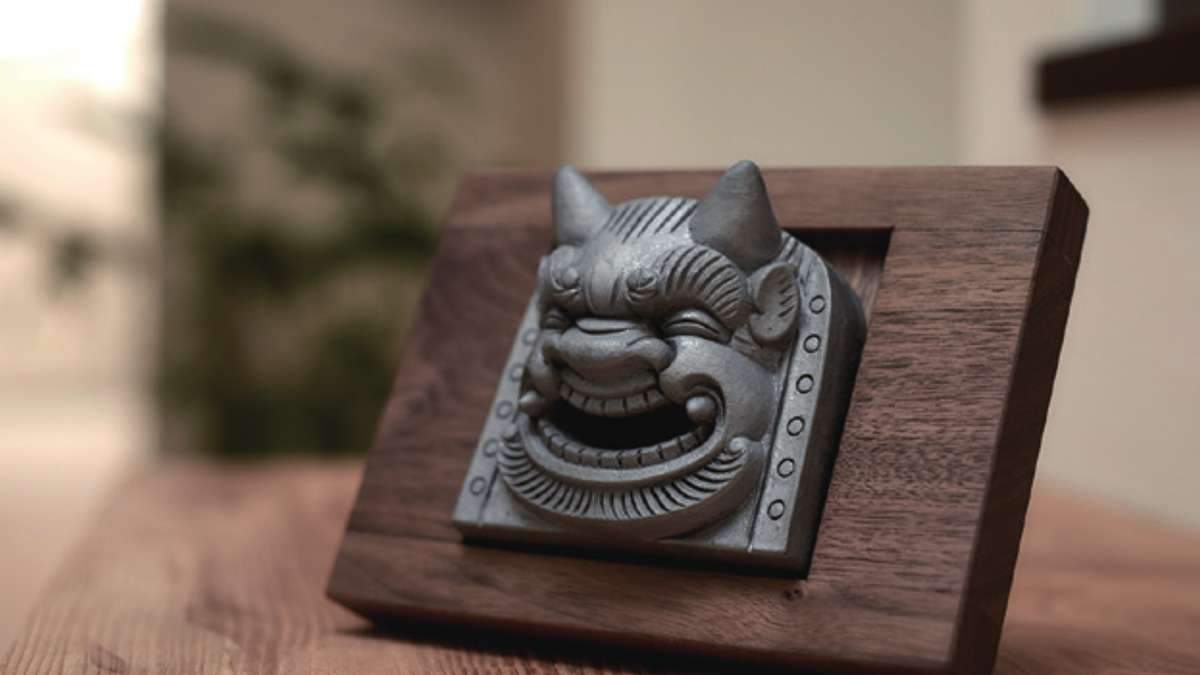free
Description

Onigawara, which has a history of 1400 years, has protected Japanese houses and families since ancient times as an amulet and amulet. However, the number of houses where onigawara can be displayed on the roof is decreasing. Therefore, in order to match the modern architectural style, we created a product that realized the novel idea of "Onigawara to decorate the room".
~ Demon Master Akihiko Hattori ~
The demon face that seals common sense and reminds us of a new world view
even the god of Bali. I am conscious of a stateless and familiar character. While retaining the traditional demon-faced features symbolically, the decorations such as beads have been omitted. By pursuing simplicity, it is a work that gives off a unique presence.
Information
| Manufacturer | Onigawara Iemori |
|---|---|
| Country of origin | Aichi Prefecture, Japan |
| Technique | Sanshu Onigawara Crafts |
| Material | Roof tile, walnut |
| Size | 5.51" * 7.87" * 1.02"(14.0*20.0*2.6cm) |
| Weight | 1.76 lbs(800g) |
| Capacity | 0 oz(ml) |
| Electronic Equipment | Comes in a paulownia wood box. Please do not touch the onigawara with your bare hands when you take it out of the box. It can be mounted both on the wall and installed. |
| Note | The product is in a paulownia box. Please do not touch orge mask with bare hands. It is possible to install both [wall hanging] and [stationery]. You can fix with plaster iron that is included even with gypsum board wall without base. |
| Delivery Time | 1-2 weeks (if out of stock + 1-2 weeks) |
Oni Shi
Create works with flexible ideas
Akihiko Hattori

History
The third generation of the 80-year-old Onigawara studio "Kito". While working on all kinds of onigawara from private houses to restoration of cultural properties, product development in new fields is underway in collaboration with the Japan Industrial Designers Association.
My philosophy
Solid technology and innovative sense
From the track record of providing works to buildings and temples that can be said to be symbols of Japan, such as the Imperial Palace, Kyoto Imperial Palace, and Izumo Taisha, his ability as a demon teacher is origami.
It was the daily training that built it, and the sense that was cultivated by actively touching the works of our predecessors.
I often get inspiration from things around me and things I encountered while traveling, and flexible thinking is the driving force for creating new works.
Creating works starts with creating tools
The right person in the right place.
Use different tools depending on the purpose, such as gold spatula if you want to polish it beautifully, and bamboo spatula if you want a rough finish.
Since the finish differs depending on the material, we often create special tools depending on the work we produce.

Focus points
A fusion of traditional and contemporary sensibilities
The motto is "Look and remember." Although he has a career of about 15 years as a demon teacher, he has seen and absorbed various works and techniques that are not limited to demon tiles.
Its strength is that it has both solid technology as a demon teacher and an innovative sense.

For Customers
For the tile culture to be reviewed
My dream is to work on historical buildings such as temples and shrines, and to review Japanese tile culture.
It is also a mission.
"In some cases, the tiles will be modified 100 years later.
At that time, I would be happy if the tiles had my name engraved on them."-
Brand history and characteristics
How Japanese Products Can Be Such High Quality
Payment & Security
Your payment information is processed securely. We do not store credit card details nor have access to your credit card information.
![[GARGOYLE (GARGOYLE STATUE) INTERIOR] JEWEL ONIGAWARA TO DECORATE THE ROOM: AKIHIKO HATTORICRAFTS | SANSHU ONIGAWARA CRAFTS | ONIGAWARA IEMORI](http://en.thebecos.com/cdn/shop/products/h-01_11ae42c9-2e12-40cc-bd37-77174f2f967d_{width}x.jpg?v=1602619985)
![[GARGOYLE (GARGOYLE STATUE) INTERIOR] JEWEL ONIGAWARA TO DECORATE THE ROOM: AKIHIKO HATTORICRAFTS | SANSHU ONIGAWARA CRAFTS | ONIGAWARA IEMORI](http://en.thebecos.com/cdn/shop/products/h_dd98fa55-512a-4174-bc7a-9e363c5d5d4f_{width}x.jpg?v=1602619989)
![[GARGOYLE (GARGOYLE STATUE) INTERIOR] JEWEL ONIGAWARA TO DECORATE THE ROOM: AKIHIKO HATTORICRAFTS | SANSHU ONIGAWARA CRAFTS | ONIGAWARA IEMORI](http://en.thebecos.com/cdn/shop/products/h-01_279_39f2411f-1d81-4b9d-9a2c-6d2afabd08a2_{width}x.jpg?v=1602619993)
![[GARGOYLE (GARGOYLE STATUE) INTERIOR] JEWEL ONIGAWARA TO DECORATE THE ROOM: AKIHIKO HATTORICRAFTS | SANSHU ONIGAWARA CRAFTS | ONIGAWARA IEMORI](http://en.thebecos.com/cdn/shop/products/h-01_289_ae58312b-b569-4a64-853d-0ffcc3bee7e4_{width}x.jpg?v=1602619997)
![[GARGOYLE (GARGOYLE STATUE) INTERIOR] JEWEL ONIGAWARA TO DECORATE THE ROOM: AKIHIKO HATTORICRAFTS | SANSHU ONIGAWARA CRAFTS | ONIGAWARA IEMORI](http://en.thebecos.com/cdn/shop/products/h-01_297-1_92533421-38d3-40df-823b-668dc910421c_{width}x.jpg?v=1602620001)
![[GARGOYLE (GARGOYLE STATUE) INTERIOR] JEWEL ONIGAWARA TO DECORATE THE ROOM: AKIHIKO HATTORICRAFTS | SANSHU ONIGAWARA CRAFTS | ONIGAWARA IEMORI](http://en.thebecos.com/cdn/shop/products/h-01_313_a36b30b0-f261-4c61-93f6-0db7b6c3f9b3_{width}x.jpg?v=1602620004)
![[GARGOYLE (GARGOYLE STATUE) INTERIOR] JEWEL ONIGAWARA TO DECORATE THE ROOM: AKIHIKO HATTORICRAFTS | SANSHU ONIGAWARA CRAFTS | ONIGAWARA IEMORI](http://en.thebecos.com/cdn/shop/products/h-01_316_3aa80b04-8e7f-496a-8436-2e69d40e024e_{width}x.jpg?v=1602620008)
![[GARGOYLE (GARGOYLE STATUE) INTERIOR] JEWEL ONIGAWARA TO DECORATE THE ROOM: AKIHIKO HATTORICRAFTS | SANSHU ONIGAWARA CRAFTS | ONIGAWARA IEMORI](http://en.thebecos.com/cdn/shop/products/h-01_330_dc508f7e-b8d3-43ff-9ae9-6275b5a75167_{width}x.jpg?v=1602620012)
![[GARGOYLE (GARGOYLE STATUE) INTERIOR] JEWEL ONIGAWARA TO DECORATE THE ROOM: AKIHIKO HATTORICRAFTS | SANSHU ONIGAWARA CRAFTS | ONIGAWARA IEMORI](http://en.thebecos.com/cdn/shop/products/h-01_334_390b1a51-fc49-4dea-b782-b619af3aff38_{width}x.jpg?v=1602620015)
![[GARGOYLE (GARGOYLE STATUE) INTERIOR] JEWEL ONIGAWARA TO DECORATE THE ROOM: AKIHIKO HATTORICRAFTS | SANSHU ONIGAWARA CRAFTS | ONIGAWARA IEMORI](http://en.thebecos.com/cdn/shop/products/h-01_11ae42c9-2e12-40cc-bd37-77174f2f967d_130x.jpg?v=1602619985)
![[GARGOYLE (GARGOYLE STATUE) INTERIOR] JEWEL ONIGAWARA TO DECORATE THE ROOM: AKIHIKO HATTORICRAFTS | SANSHU ONIGAWARA CRAFTS | ONIGAWARA IEMORI](http://en.thebecos.com/cdn/shop/products/h_dd98fa55-512a-4174-bc7a-9e363c5d5d4f_130x.jpg?v=1602619989)
![[GARGOYLE (GARGOYLE STATUE) INTERIOR] JEWEL ONIGAWARA TO DECORATE THE ROOM: AKIHIKO HATTORICRAFTS | SANSHU ONIGAWARA CRAFTS | ONIGAWARA IEMORI](http://en.thebecos.com/cdn/shop/products/h-01_279_39f2411f-1d81-4b9d-9a2c-6d2afabd08a2_130x.jpg?v=1602619993)
![[GARGOYLE (GARGOYLE STATUE) INTERIOR] JEWEL ONIGAWARA TO DECORATE THE ROOM: AKIHIKO HATTORICRAFTS | SANSHU ONIGAWARA CRAFTS | ONIGAWARA IEMORI](http://en.thebecos.com/cdn/shop/products/h-01_289_ae58312b-b569-4a64-853d-0ffcc3bee7e4_130x.jpg?v=1602619997)
![[GARGOYLE (GARGOYLE STATUE) INTERIOR] JEWEL ONIGAWARA TO DECORATE THE ROOM: AKIHIKO HATTORICRAFTS | SANSHU ONIGAWARA CRAFTS | ONIGAWARA IEMORI](http://en.thebecos.com/cdn/shop/products/h-01_297-1_92533421-38d3-40df-823b-668dc910421c_130x.jpg?v=1602620001)
![[GARGOYLE (GARGOYLE STATUE) INTERIOR] JEWEL ONIGAWARA TO DECORATE THE ROOM: AKIHIKO HATTORICRAFTS | SANSHU ONIGAWARA CRAFTS | ONIGAWARA IEMORI](http://en.thebecos.com/cdn/shop/products/h-01_313_a36b30b0-f261-4c61-93f6-0db7b6c3f9b3_130x.jpg?v=1602620004)
![[GARGOYLE (GARGOYLE STATUE) INTERIOR] JEWEL ONIGAWARA TO DECORATE THE ROOM: AKIHIKO HATTORICRAFTS | SANSHU ONIGAWARA CRAFTS | ONIGAWARA IEMORI](http://en.thebecos.com/cdn/shop/products/h-01_316_3aa80b04-8e7f-496a-8436-2e69d40e024e_130x.jpg?v=1602620008)
![[GARGOYLE (GARGOYLE STATUE) INTERIOR] JEWEL ONIGAWARA TO DECORATE THE ROOM: AKIHIKO HATTORICRAFTS | SANSHU ONIGAWARA CRAFTS | ONIGAWARA IEMORI](http://en.thebecos.com/cdn/shop/products/h-01_330_dc508f7e-b8d3-43ff-9ae9-6275b5a75167_130x.jpg?v=1602620012)
![[GARGOYLE (GARGOYLE STATUE) INTERIOR] JEWEL ONIGAWARA TO DECORATE THE ROOM: AKIHIKO HATTORICRAFTS | SANSHU ONIGAWARA CRAFTS | ONIGAWARA IEMORI](http://en.thebecos.com/cdn/shop/products/h-01_334_390b1a51-fc49-4dea-b782-b619af3aff38_130x.jpg?v=1602620015)

